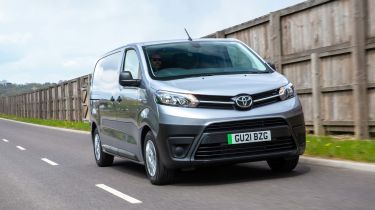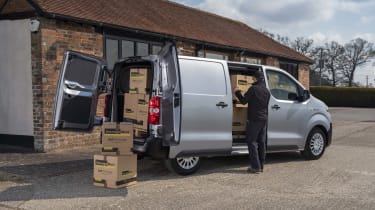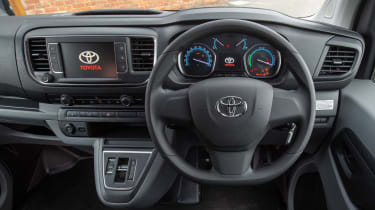Toyota Proace Electric review
The Proace is a medium-sized electric van with over 200 miles of range, but it’s only available in one configuration

Pros
- Five-year warranty
- Comfortable to drive
- Up to 200 miles of range
Cons
- Only one trim level
- Just one body style
- Not the biggest interior
| Battery size | Range | Wallbox charge time | Rapid charge time |
|---|---|---|---|
| 50kWh | 142 miles | 4hrs 45mins | 32mins (10-80%, 100kW) |
| 75kWh | 205 miles | 7hrs | 48mins (10-80%, 100kW) |
The Toyota Proace is the brand’s first electric vehicle of any kind to be sold in the UK, which might come as a surprise given that the Prius and other hybrid models have been staples in the Toyota range for decades.
Toyota is set to launch passenger cars with electric power soon, starting with the bZ4X, but for now the Proace leads the way, because it shares technology with the Citroen e-Dispatch, Vauxhall Vivaro-e and Peugeot e-Expert vans. All these models are closely related, and other rivals with different technology include the Volkswagen Abt eTransporter and Mercedes eVito.
The Proace is a medium-sized panel van with a 50kWh battery, so it’s able to travel 142 miles on a charge. It's possible to get a version with a 75kWh battery that boosts range to 205 miles, but whichever battery you choose, the van is driven by a single electric motor that produces 136bhp and 260Nm of torque.
There are a range of driving modes to select, including Eco (which can add around 10 miles of range by limiting the power and turning off the air-conditioning), Power (to access full motor power) and Normal (a balance of the two). Like all electric cars and vans, the Proace is punchy from low speeds, because of the motor’s instant torque delivery.
The electric version of the Proace is more relaxing than the diesel model, as there’s no noisy engine and it’s really smooth to drive. It even feels more stable in corners because the battery is mounted low down, under the floor, and the brakes feel natural despite being regenerative (they harvest energy to put back into the battery as you slow down).
We like the driving position in the Proace, as it gives a good view of the road and feels quite car-like rather than being perched in a van. Best of all, the Toyota is comfortable over bumps, so driving on pothole-covered city streets isn’t too much of a chore. The Proace Electric can charge at speeds of up to 100kW from a rapid charger, which means you can replenish the 50kWh battery model to 80% capacity in 32 minutes, or the 75kWh version in 48 minutes.
If rapid charging isn't available, the Proace is equipped with a 7kW on-board charger, but there's an option for an 11kW on-board charger for faster wallbox charging (provided your home or commercial premises has three-phase electricity). Recharging from an 11kW wallbox will take four hours and 45 minutes for the 50kWh model, or seven hours if the larger 75kWh battery is fitted. Those times will be longer if you use one of the more commonly found 7.4kW wallbox chargers to top up the Proace at home.
As the Proace Electric’s batteries are under the floor, there’s no impact on space in the rear, which offers 5.3 cubic metres of load volume. But unlike the other vans produced by Stellantis that we mentioned above, the Proace is only available in one body length, body style and roof height.
The maximum payload is one tonne, which is also slightly reduced compared to the diesel Proace. Another issue is the Proace Electric’s doors are on the small side, which will restrict you from lifting in bulkier items, but the van does come with two sliding side doors as standard.
The Proace Electric also comes with plenty of safety kit, including stability control, hill-start assistance, twin front airbags, tyre-pressure monitoring and a speed limiter. However, other Stellantis vans are available with lane-keeping assistance and speed-limit recognition, which the Proace doesn’t get. One advantage the Toyota offers compared with its sister vans is that all Toyotas have the availability of up to 10 years’ warranty on a rolling basis and five years' roadside assistance. On top of that, the Proace Electric's battery is covered for eight years or 100,000 miles, whichever comes sooner.
The Proace Electric is only available in Icon trim, but is still generously equipped, with automatic lights and wipers, a seven-inch touchscreen, cruise control, rear parking sensors and air-conditioning all included, as well as Apple CarPlay and Android Auto. Prices for the Proace Electric with the 50kWh battery start at around £35,000, rising to about £41,000 for the larger 75kWh model after the UK Government’s grant for electric vans has been deducted.
Overall, the Proace Electric, like its Stellantis siblings, offers you a more refined and comfortable ride than the typical diesel light commercial vehicle. The Proace is also well equipped and can be charged quickly if you have access to a fast enough charger. The only downsides are that the van is limited to one body length and style, and the interior can feel cramped if all three seats are occupied.


